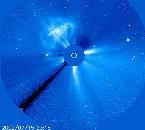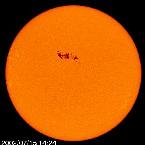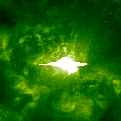Flashpoint! An X-3 flare (July 17, 2002)



- LASCO Movie (MPEG,324K)
- MDI Movie (MPEG,624K)
- EIT Movie (MPEG,101K)
- LASCO Movie (Quicktime,2.3M) and a smaller version (Quicktime,426K)
- MDI Movie (Quicktime,3.2M) and a smaller version (Quicktime,613K)
- EIT Movie (Quicktime,1.3M)
- LASCO Higher resolution Image (TIF,4.4M)
- MDI Higher resolution Image (TIF,2.8M)
|
On 15 July 2002, a large (X-3) flare and a coronal mass ejection
(CME) exploded out from the Sun, the largest flare observed since 28
December 2001. We have seen only four X-class flares this year. The
source of the flare and CME was Active Region 30, which scientists
were watching carefully as it had the characteristics of sunspots
that produce X-class flares. The large sunspot region (many Earths
across) can be seen in the MDI video clip and still image up to just
hours before the flare. The trademark flash point of the flare was seen in the ultraviolet EIT 195 Angstrom image at about 20:12 UT. The LASCO C3 instrument shows a fast-moving cloud of particles heading off left of center over the course of a few hours. Thus, it may deliver a glancing blow to Earth. The leading edge of the CME may reach us on July 17 or soon thereafter and may generate some intense auroral activity. SOHO began its Weekly Pick some time after sending a weekly image or video clip to the American Museum of Natural History (Rose Center) in New York City. There, the SOHO Weekly Pick is displayed with some annotations on a large plasma display. If your institution would also like to receive the same Weekly Pick from us for display (usually in Photoshop or QuickTime format), please send your inquiry to steele.hill@gsfc.nasa.gov. |


